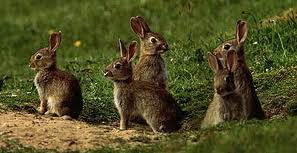

Rabbits are generally nocturnal and they also are relatively silent. Rabbits are active throughout the year, no species is known to hibernate. Most rabbits are relatively solitary and sometimes territorial, coming together only to breed or occasionally to forage in small groups.ĭuring territorial disputes rabbits will sometimes ‘box’ using their front limbs.

The European rabbit is the most social rabbit, sometimes forming groups in warrens of up to 20 individuals. They use regular trails, which they scent mark with faecal pellets. The nest at the end of the tunnel is lined with grass, moss and belly fur. The European rabbit constructs the most extensive burrow systems, called warrens. Rabbits are incapable of vomiting due to the physiology of their digestive system. If the environment is relatively non-threatening, the rabbit will remain outdoors for many hours, grazing at intervals. In this time, the rabbit will also excrete many hard faecal pellets, being waste pellets that will not be reingested. Rabbits graze heavily and rapidly for roughly the first half hour of a grazing period (usually in the late afternoon), followed by about half an hour of more selective feeding. Rabbits re-swallow up to 80% of their faeces to use their food more efficiently in a process known as ‘refection’. Rabbits are herbivores who feed by grazing on grass, forbs and leafy weeds, however, they will also eat all vegetable matter and gnaw tree bark in winter months. Rabbits are abundant in grassland areas where the soil allows them to make extensive, well-drained burrows, but also where there are hedges or patches of woodland to give shelter and cover. The European rabbit occupies open landscapes such as fields, parks and gardens. Rabbits are ground dwellers that live in environments ranging from desert to tropical forest and wetland. The smallest is the pygmy rabbit (Brachylagus idahoensis), at only 20 centimetres in length and 0.4 kilograms in weight, while the largest rabbits grow to 50 centimetres and more than 2 kilograms. Wild rabbits are rather uniform in body proportions and stance. Their long ears of rabbits are most likely an adaptation for detecting predators. They have compact bodies with long, powerful hind legs.Ī Rabbits fur is generally long and soft and is grey/brown in color and they have white underparts and a short tail. Rabbits generally measure 40 – 45 centimetres in length and have ears that measure 8.5 centimetres long. The male is called a buck and the female a doe. The rabbit pre-breeding season population is estimated to be 40 million. The main predators of rabbits are the stoat and the fox, although young rabbits also fall to birds of prey and weasels. In the 1950s, the disease myxomatosis was introduced to curb their numbers and the rabbit almost became extinct, however, it is once again a common animal of the British countryside although it can be a serious pest for farmers for eating and damaging crops. All breeds of domestic rabbit originate from the European. There are many other species of rabbit and these, along with pikas and hares, make up the order Lagomorpha. There are seven different genera in the family classified as rabbits, including the European rabbit (Oryctolagus cuniculus), Cottontail rabbit (genus Sylvilagus 13 species), and the Amami rabbit (Pentalagus furnessi, endangered species on Amami Oshima, Japan). Many escaped into the wild and eventually become so common that farming them was no longer economic.īecause of their fast breeding, a diet of virtually any vegetable matter and persecution of predators, the rabbit slowly established itself in the wild in Britain, despite originally favouring a warmer, drier climate. The rabbit was brought to England in the 12th century AD by the Normans and kept in captivity in warrens as a source of meat and fur. Rabbits (Orytolagus cuniculus) originated from Spain and South-West France.


 0 kommentar(er)
0 kommentar(er)
